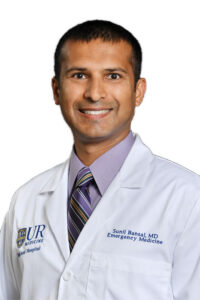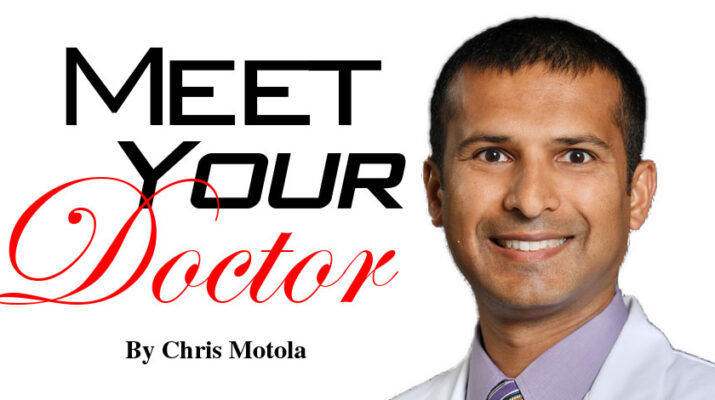Highland ER doctor, who recently earned the hospital’s title of doctor of the year, talks about the stress, the rush, the work of treating COVID-19 patients and keeping staff and other patients safe
By Chris Motola

Q: Highland Hospital nominated you as doctor of the year. How’d you pull that off?
A: Yes, they did. Fortunately I work with incredibly esteemed colleagues and peers, and I was nominated by my colleagues and peers. Being nominated by such a high-quality group of physicians and other colleagues and peers has been very humbling. I’ve been at Highland for close to 10 years now and have gotten to know quite a few of the physicians, nurses and advanced practice providers. Its annual award is given to one physician.
Q: Quite the year to win it in, too.
A: It was actually the 2019 award, with the nominations coming in in 2019. Then they announce the winner in 2020. It was just about the same time that COVID-19 was starting to take off in the U.S., so it didn’t get quite as much traction as it normally would.
Q: You’re in emergency medicine. What kind of impact has the virus had on your practice this year?
A: It’s had an incredible impact. It’s required us to be very nimble and very accommodating to the ever-changing times. In spring we did a lot of preparation. We were ready for a surge. It never really came then. It was nothing like it is now. As I’m sure you know, the numbers are spiking. It’s dramatic. Trying to keep the patients who are coming in safe, trying to keep the staff safe. And also trying to see patients who are coming into the department with non-COVID issues. Those are the patients who tend to be scared to come in. Those fears are very justifiable, but we’re doing our best to keep people safe and keep exposures to a minimum. So it’s had a dramatic impact on how we practice.
Q: Has COVID-19 increased or decreased the patient inflow at Highland’s emergency department?
A: In the spring it reduced inflow for quite some time. I think what we saw was a fear of [people] coming into the hospital. Some of those patients probably didn’t have emergency conditions, but there were also patients who had emergency conditions who weren’t coming in, and that’s a bad thing obviously. Then over the summer we started to see our numbers start to normalize as COVID was fairly dormant in our area. Now we’re starting to see the numbers rise, but we’re still not at the level we were at pre-COVID. With that being said, we’re practicing in a very different environment with social distancing and the requirements to wear personal protection equipment. So it’s a lot more time-consuming to see patients than it used to be.
Q: What effect has all this had on relationships between coworkers?
A: Fortunately, I think the healthcare professionals at Highland Hospital have handled this extremely well. It’s exhausting, there’s no doubt about it. People are working more hours than they were, or necessarily want to, but as it’s a smaller place and we feel like a team, and see the same people each day, I think we’ve done a pretty good job of keeping moral up. I think relationships have remained very collegial within the emergency department, and to all the other departments in the hospital. We’re in the thick of it right now, and who knows how much longer this is going to last, but I think we’re doing great as an institution.
Q: What advice would you give to people in similar roles?
A: I think the most important thing is that we support each other. That we all understand that each of us are facing different hardships. What’s challenging for me on a given day may be different than what’s challenging for a nurse or a patient care technician. I think acknowledging that and trying to see through their perspective has really helped. And just being mindful of the fact that we’re all under stress. And we don’t want to see people getting sick and leaving the healthcare workforce, so I think my advice would be to support one another.
Q: What’s an example of supporting your team?
A: In the emergency department we’re constantly under time pressure and crunches, and the need to make room for other patients. That can be challenging. If a nurse or colleague is assigned to take care of a new patient but is managing a very sick patient with COVID, that may delay the ability of that person to get to another patient. So being understanding of that, or talking to a charge nurse or other nurse to help that individual who is occupied with another sick patient. Checking in on each other’s patients. So those are the kinds of things we’re doing on a day-to-day basis to help each other out.
Q: Do you see this COVID-19 spike playing out differently than the spring?
A: I can tell you right now that we’ve far exceeded hospitalizations due to COVID during this current spike than we did in the spring. Even the severity of illness has increased. We are seeing a lot of patients with COVID who can be managed at home, so we’re able to discharge them from the hospital. But we are seeing a lot of patients with respiratory issues that require hospitalization. I don’t think we’ve hit the peak yet. Overall, I think this surge seems to be much more severe than the first.
Q: New York had the second worst death rate in the country from COVID, most of that from the spring. Why aren’t we seeing the huge death rates this time around?
A: I think a lot of it is preparation. It’s also more spread out through the nation now whereas it very concentrated around the New York City area.
Lifelines
Name: Sunil K. Bansal, M.D.
Position: Assistant medical director for the emergency department at Highland Hospital; assistant professor of clinical emergency medicine, University of Rochester School of Medicine and Dentistry
Hometown: Pittsford
Education: SUNY Buffalo School of Medicine; board-certified physician in emergency medicine, and a fellow of the American College of Emergency Physicians
Affiliations: Highland Hospital; Strong Memorial Hospital
Organizations: American College of Emergency Physicians; American Board of Emergency Medicine
Family: Wife, three children
Hobbies: Hiking, running, reading, whiskey enthusiast

